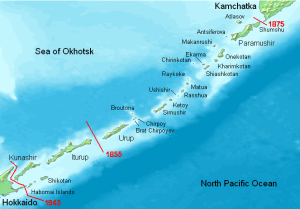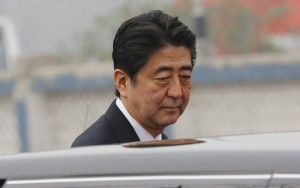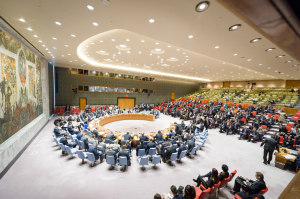Christof Lehmann (nsnbc) : Russia’s Prime Minister Dmitry Medvedev has approved the deployment of Russian warplanes to the disputed Northern Japanese Territories a.k.a. South Kuril Islands in Russia. The Soviet Union occupied the islands after the end of World War II. The Russian Federation is currently in the process of permanently annexing the disputed islands, blackmailing Japan to either cooperate and be part of their “development”, or to lose out on “the business opportunity”.
Japanese authorities have yet to comment on the Russian Federation’s latest push to militarize and permanently annex Japan’s disputed Northern Territories or the South Kuril Islands as Moscow calls the islands of Iturup, Shitokan, Kunashi and Etorofu, as well as the Habomai Archipelago.
On Thursday, February 1, 2018, Russian Prime Minister Dmitry Medvedev signed a “decree” to allow Russian warplanes to use a civilian airport on the islands for military purposes.
The decision came ahead of a scheduled meeting between the deputy foreign ministers of the two countries to discuss cooperation on the disputed territory and Japan’s decision to allow Washington to build a military base there.
Russia occupied Japan’s Northern Territories after World War II and is in the process of a de facto annexation of the disputed islands. In 2016 Russia blackmailed Tokyo, stressing that Japan better act soon if it wants to benefit from Russia’s much criticized development of the Russian-occupied northern Japanese territories.
The statement followed an earlier “take it or leave it” suggestion styled to Japan that was widely perceived as an attempt to blackmail Tokyo. During his annual Q&A session in April 2016, Putin answered questions about the disputed northern Japanese territories, designated as South Kuril Islands by Russia, saying that he “expects” that a compromise will be found “some day”. Putin added that he welcomes the upcoming visit if Japanese PM Shinzo Abe and the they “of course, will be discussing all problems. Putin noted:
“But at the same time we are also seeing other things: despite pressure from their partners, in particular from the United States, our Japanese friends still seek to maintain these relations”.
Ironically, both Moscow and Washington contribute to the stalemate and Moscow’s creeping de facto annexation of the disputed territories. A small feat for the two most powerful members of the UN Security Council.
Moscow’s unwillingness to sign a peace agreement with Japan, to return the occupied northern Japanese territories, that is the islands of Kunashir, Iturup, Shikotan as well as the Habomai archipelago is forcing Tokyo’s hands with regard to its relations with the United States.
Neither the permanent UN Security Council member USA nor Russia have yet taken steps to implement the UN General Assembly resolution that calls for removing so-called “enemy state clause” that designates Japan, Germany and Italy as enemy states to the UN from the UN Charter. “Legally speaking” this empowers any full UN member to launch “preemptive military actions” against Japan and the other two “enemy states” without a declaration of war.
In February 2016 the Russian Foreign Ministry continued Moscow’s PR campaign about the disputed territories by slamming an unnamed Japanese diplomat for distorting the historical facts when speaking about the peace treaty that has still not been signed, some seventy years after the conclusion of World War 2.
The Russian Foreign Ministry issued a statement that was republished in the Russian State news agency Tass, saying that:
“(We) paid attention to an interview of a responsible employee of the Japanese Foreign Ministry on the problem of the peace treaty with Russia. In it, the Japanese diplomat said, in particular, that “not all results of World War II had been summed up” between Moscow and Tokyo and that the so-called territorial issue needs to be resolved. … We express our sincere regret over the fact that the Japanese side is trying to launch a public discussion on the sensitive issue of the bilateral relations allowing arbitrary and distorted interpretation of historical facts at that.”
The permanent UN Security Council member Russia is due to its mandate bound to particular accuracy with regard to international disputes. Moscow, however, presents a grossly simplified, if not self-suiting version of what it describes as “the historical facts” that Tokyo must learn to accept as precondition for a peace treaty. Russian State news agencies and media generally limit the discourse by merely stating the following (as in Tass):
After World War II, in September 1945, Japan signed the capitulation, and in February 1946, the Kuril Islands were declared territories of the Soviet Union.
 The Soviet Union (USSR) ignored the issue and Japanese concerns entirely. After the discontinuation of the USSR, the first President of the Russian Federation, Boris Yeltsin, conceded that the South Kuril Islands or the Northern Japanese Territories are disputed. The territories include the islands of Iturup, Kunashir, Shitokan, Etorofu and the Habomai Archipelago. (see map)
The Soviet Union (USSR) ignored the issue and Japanese concerns entirely. After the discontinuation of the USSR, the first President of the Russian Federation, Boris Yeltsin, conceded that the South Kuril Islands or the Northern Japanese Territories are disputed. The territories include the islands of Iturup, Kunashir, Shitokan, Etorofu and the Habomai Archipelago. (see map)
The islands are geologically distinct from Russia’s Kamchatka peninsula (see map above). Japan discovered and surveyed the islands prior to Russia or the USSR. Although there has long existed close cultural ties between the occupants of the Kamchatka peninsula and the Northern Japanese territories, the people on Iturup, Kunashir, Shitokan, Etorofu and the Habomai Archipelago have had a distinct Japanese culture. In relatively contemporary history Japan effectively established control over the islands by the early 19th century.
In 1855, the Treaty of Commerce, Navigation and Delimitation between Japan and Russia, which was concluded in a friendly and peaceful manner, confirmed the already established natural boundaries, drawing the boundary between the islands of Etorofu (the northernmost island of the Northern Territories) and Uruppu. The Four Northern Islands had never been held by any other country than Japan.
WW II and the Occupation of the Islands by the Soviet Union
Moscow bases its claim to the islands on the fact that the USSR occupied the islands in 1946, after the end of WW II. The Russian Federation, considering itself as the successor of the Soviet Union, considers that the invasion of the islands was a lawful act of war, and that Tokyo has to accept the fact that it has lost. It is especially the latter argument that is particularly problematic when it is being used by a permanent UN Security Council member.
However, nearing the end of the Second World War, the Soviet Union, in violation of the Neutrality Pact that was still in force between Japan and the Soviet Union, opened the war with Japan. Even after Japan accepted the Potsdam Declaration, Soviet forces continued its offensive against Japan and occupied all of the Four Northern Islands from 28 August 1945 to 5 September 1945.
Russia’s Ethnic Cleansing of Japan’s Northern Territories an Ongoing Process
Subsequent to the occupation of the islands, the Soviet Union unilaterally incorporated the territories without a basis in international law. In 1949 the USSR forcibly deported some 17,000 Japanese residents from the islands. Contemporary international law would define this forced deportation as ethnic cleansing and, arguably, as genocide.
Moscow repeatedly assured that it wants to find a solution that is acceptable for both countries. Tokyo agrees in principle but stresses that:
In order to solve this issue and to conclude a peace treaty as soon as possible, Japan has energetically continued negotiations with Russia on the basis of the agreements and documents created by the two sides so far, such as the Japan-Soviet Joint Declaration of 1956, the Tokyo Declaration of 1993, the Irkutsk Statement of 2001 and the Japan-Russia Action Plan of 2003.
Today the Russian Federation continues the USSR’s ethnic cleansing policy under the guise of a social and infrastructure development project while it makes Japan’s recognition of the de facto annexation a precondition for a peace treaty. This de-factor annexation is increasingly being bolstered by Russia’s militarization.
In August 2015 the otherwise skillful Russian Foreign Minister Sergey Lavrov displayed what was widely perceived as an unusual display of arrogance and victor’s justice when he commented on the Japanese government’s objections about Russia’s “social and cultural development” of the occupied territories, saying:
“Unacceptable comments from Japan on the trips by Russian government officials to the Southern Kuril Islands have come again recently. … We would like to recall we do not plan taking account of the Japanese government members’ opinions as we arrange the itineraries for members of the government. These trips, including the one that government officials make as part of a federal program for social and economic development of the Kuril Islands (the Sakhalin region), will continue. … We are compelled to state that the Japanese side is again demonstrating overtly its negligence of the commonly recognized results of World War II as it multiplies publicly its ungrounded claims to the Southern Kuril Islands. … Such actions look particularly deplorable on the background of the forthcoming 70th anniversary since the end of World War II.”
In late January 2016 Moscow upped the blackmail ante by signaling that it is looking for “foreign partners” to develop “Russia’s South Kuril Islands” while pressuring Tokyo to better make a quick decision if it wants a cut of the deal, including fishing rights in the waters around the four islands. In fairness, one must concede that Russia’s policy may at least in part be driven by the policies of fellow UN Security Council member USA, the so-called US pivot in Asia and the fact that Japan, as enemy State to the UN has no realistic possibility to oppose the United States’ military presence in Japan. Russia and China, meanwhile, use well-proven propaganda techniques to accuse the still not fully sovereign, de facto occupied Japan of militarism, ultra nationalism and of having imperialist ambitions.
CH/L – nsnbc 03.02.2018
Source Article from https://nsnbc.me/2018/02/03/russia-to-deploy-warplanes-to-disputed-northern-japanese-territories-a-k-a-south-kuril-islands/
 RSS Feed
RSS Feed















 February 4th, 2018
February 4th, 2018  Awake Goy
Awake Goy 














 Posted in
Posted in  Tags:
Tags: 













